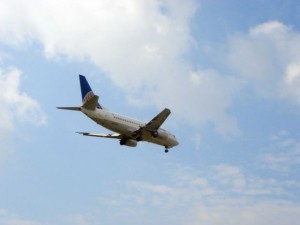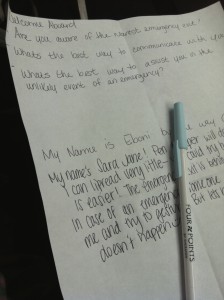#DeafInTheAir aims to improve airport accessibility
by Sara
 I can list so many things that make my air travel difficult.
I can list so many things that make my air travel difficult.
Let’s begin with a few: Imagine sitting at the airport, waiting for your flight to be called…but the flight never comes. It has been delayed, and you didn’t know. The flight delay was announced through the speakers, but you can’t hear. Or what about when your flight gets cancelled?
I shy away from telling flight attendants that I’m deaf, because with the “deaf card” attendants will shuttle me to the front of the line at boarding and hand-hold me down the terminal to make sure I arrive at my correct destination. I don’t ask for help, because I don’t need the “shuttling” and “hand holding” through the airport or the airplane itself. I always feel guilty and embarrassed when I bypass the line, even sometimes bypassing older people who use wheelchairs.
And oh, what about the amazing in-flight entertainment? There are times I’ve thought, “I haven’t seen this movie before”, and I settle in my seat and “oh…it’s not captioned.” Others can turn on other language subtitles, but there are no English subtitles. So I turn to my book.
Why is this still happening in this modern technology era, 2014?
I’ve been through multiple embarrassing and annoying plane rides, but there’s one plane trip I remember most vividly. It could’ve gone poorly, but turned out amazing, and here’s why: The flight staff didn’t know I was deaf, so I wasn’t “shuttled” or “hand-held” down the terminal. I was seated at the emergency exit, though, so I was required to tell a flight attendant that I had a disability (people with disabilities are not encouraged to sit in an exit row, as they’d need to be “able-bodied” to help others off the plane in case of an emergency). Airline policy would not allow them to downgrade my seat to the back of the plane, so I got upgraded…to FIRST class!
Even better, I got a fabulous note from the stewardess asking me if I knew where the nearest emergency exit was, what was the best way to communicate with me and what was the best way I could be assisted in case of an emergency. We had a back and forth dialogue about the questions she asked, just by writing notes to each other. This was a first.
This stewardess didn’t take over and help me without me asking, but she made it clear that she would be there if I needed anything. This was an amazing flight!
But, most flights aren’t so amazing for the deaf community, and there is someone doing something to help. I first heard of Elena Mayer’s National Association of the Deaf Youth Ambassador Program presentation through a couple of tweets from National Association for the Deaf (NAD), plus from my friends who attended Elena’s presentation.
I was thrilled to have an interview with her last week — she’s 20, from St. Louis and is a current student at California State University at Northridge. She has been increasingly frustrated with the lack of accessibility at airports for people who are deaf. She knows the younger generation is very social-media savvy (a benefit to the deaf community), so she decided to do something about the lack of accessibility using #DeafInTheAir.
In Elena’s presentation, she mentioned that of 20,000 disability related complaints at airports, only 214 were from people who were deaf. Elena hopes that #DeafInTheAir will encourage more people who are deaf to speak out about their complaints and make them public.
By having #DeafInTheAir available, people who are deaf will be able to share their stories about the lack of accessibility in airports or on airplanes via Facebook, Twitter or Instagram. For example, if I were to write a tweet to an airline complaining of the lack of captioning in their in-flight entertainment, I would type out the complaint and add #DeafInTheAir. This way, other people that are tracking the hashtag will be able to re-tweet me and spread the message.
Elena is hoping to work with NAD and various airlines to get English movie/TV captioning on flights and have a special sign posted next to the gate that will allow for communication between a deaf passenger and the flight attendant/gate attendant when needed — a back-forth typing screen or, if you want to go low-tech, a whiteboard with markers.
Elena’s dream for more accessibility in airports can come true with your help! If you see something that could disrupt a person’s travel because of lack of accessibility with captioning, or if you notice educational about people who are deaf that others should know about, use Facebook/Twitter/Instagram with the hashtag #DeafInTheAir!
With this hashtag campaign, maybe things at airports will change. People who are deaf, like me, have been fighting the airlines about movie captions for so long, and we’ve made very little progress. A united front with repeated messages through #DeafInTheAir might make our captioning dreams come true.
No one should ever feel embarrassed to board a plane, or feel lost when it comes to communicating delays/cancellations. If you have a story to tell, please use #DeafInTheAir and spread awareness about changing the airports/airlines’ policy on modes of communication or captions.
If you want to contact Elena Mayer, please contact her via Twitter — @DeafInTheAir. Connect on the official Instagram for #DeafInTheAir here.
Learn about accessible transportation options from Easter Seals too, with Easter Seals ProjectACTION.







